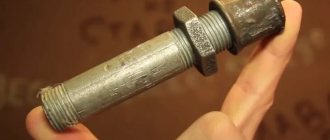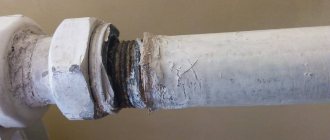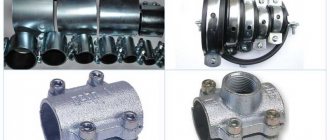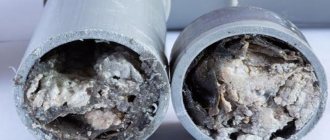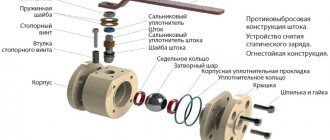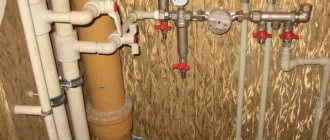Instead of metal pipes in private buildings and apartments, similar products made of polypropylene are widely used when installing utility lines. They are lighter weight and have a longer service life.
However, even such high-quality modern material can leak. To reduce the likelihood of repairing polypropylene pipes or quickly eliminating an emergency situation, you need to have information regarding the reasons for the leakage of polymer pipelines.
Is it even possible to do this?
It is quite possible to patch up a pressure pipe that unexpectedly leaks on your own using improvised means.
The only caveat is if the leak is insignificant , and the water oozes slightly, and does not gush in an endless stream.
When the accident is more serious, you will need to urgently tighten the valve that controls the water supply to the coolant, and then call a repair service.
Rules for choosing a material to solve a problem
When the cause of the pipe damage has been established, it is necessary to look for acceptable repair methods. There are several of them. Only most are suitable for low water pressure in the water supply circuit or heating system.
The most common way out of a difficult situation is to use an industrial clamp (screed). This is a metal ring with thick walls, a rubberized inner surface and a fastening nut for a tie.
If you don’t have such a device at hand, then any piece of rubber (for example, from a bicycle inner tube) and wire or something similar will do .
But other methods of eliminating leaks when it comes to heating or hot water supply systems are unlikely to work. Thus, often used cold welding and special sealants are not relevant for wet surfaces.
Other instantly hardening composites (epoxy resin, dichloroethane) are also excluded, since they can be used on dry and disconnected water supply routes.
A minor leak in the pipeline can be repaired on your own .
But this will only be a temporary measure. At the end of the heating season, it is recommended to carry out major repairs so that the system no longer fails.
Store products
Sealants can be used for straight sections of heating system pipes and threaded connections:
- Silicone - they are elastic, harden easily, penetrating into hard-to-reach places. This group includes silicone sealant “Moment”.
- Polyurethane - resistant to external factors. They come in one- and two-component types, form stable compounds with metal, and protect against corrosion. The downside is the high cost. One of these sealants is TYTAN.
- Liquid sealants. For each type of connection, their own compositions are used: for pipes installed in water, for contact with antifreeze, for metal and plastic pipes.
Hot and cold H2O - is there a difference in the way the gap is sealed?
It's all about the difference in coolant temperature. It is this factor that is decisive when choosing a material.
With hot pressure, minor damage can heal without outside intervention . Larger gaps can be easily repaired with regular salt and a bandage.
But when the water cools, the flow will resume. It will not be possible to fix a leak in a cold water pipe with salt and a bandage. It is easier to repair a failed hot water pipe in the summer when it is turned off. Then you don’t have to control the temperature in the room while fixing the leak.
Why can a plastic pipe installation connection leak?
If we do not take cases related to accidents, then there may be several reasons for the failure of the installation connection:
- the nut is simply loose,
- the fitting was pressed unprofessionally,
- a technological error made itself felt when selecting the temperature regime during the butt welding procedure.
If the nut is loose, the problem can be solved most quickly. As a rule, just tightening the nut is enough. It's easy to do it yourself. The only thing is that you must carefully inspect the lock nut (there may be cases where it is damaged) and check the integrity of the gasket. There is no point in tightening the nut if it is damaged or there are problems with the gasket.
If the problem is incorrect pressing of the fitting, then it is better to use a new element for joining. Repeated pressing of the fitting will not give the desired effect.
Replacement of the old unit is also necessary if the integrity of the joint is damaged due to incorrect selection of the temperature regime.
Experts recommend replacing the unit in the following order:
- Shut off the pipeline.
- Cut out the connecting element using a special tool.
- Prepare and install new fittings (welded or threaded).
When installing threaded fittings, it is most important to take care of the insulation of the joint. Here FUM tape, which is made from fluoroplastic-4D, or sealants will come to the rescue. Moreover, as practice shows, the use of sealants is considered a more effective solution compared to insulation with FUM tape. Indeed, during water hammer and vibration in the pipeline, FUM tape, alas, can prove to be far from being the most reliable insulation.
How does the pipeline material affect the solution to the problem?
Metal pipes are distinguished by their enviable resistance and durability. Almost their only drawback is their susceptibility to corrosion. This is often what causes a leak in the circuit.
Less commonly, other pipelines also fail: plastic, polypropylene (mainly in places of threaded or fitting connections).
Metal pipes are the most difficult to seal, since electric welding is not applicable to them. After such exposure, corrosion processes only become more active.
It is enough to compress the plastic pipe in the problem area, and all manipulations can be carried out under water pressure. The main thing is not to overdo it with the screed, otherwise the plastic will crack, and then you will have to replace the entire pipe.
A polypropylene pipeline can be easily repaired by soldering a separate fragment; a metal-plastic pipeline requires inserts . In the latter case, if the damage is not extensive, wrapping with electrical tape or treating with an adhesive (polyurethane, epoxy) will be sufficient.
Elimination of leakage of a threaded connection when the water supply is turned off
After shutting off the water and freeing the pipe from the fittings using a pipe wrench, you need to make sure that there is no crack, since in this case only replacing a section of the pipe is effective.
If there is no crack, the steps are as follows:
- the connection is cleaned of rust;
- wrap tow on the thread in combination with paint or Unipack composition, FUM tape or a special thread;
- tighten the connection manually;
- tighten using a pipe wrench.
How to solve a problem?
When water circulates under pressure in the pipes, most major repairs cannot be done. Therefore, you have to act in other available ways in order to at least temporarily stop the leak and wait for emergency services.
Using a self-tapping screw
This option is applicable only for minor holes with a diameter of no more than 3-4 mm .
To plug the hole, you need a galvanized self-tapping screw, which is additionally equipped with a press washer.
It is simply screwed into the hole and secured . As a result, the water is blocked. After such repairs, the pipe can last up to 3 years, but it is better to replace the burst fragment as soon as possible. In addition, a self-tapping screw inside the pipeline leads to clogging of the system.
Cementing
Cast iron or steel pipes can be easily patched using cementation.
The sequence of actions is as follows:
- Using a special hard metal brush, carefully remove the layer of rust in the area of the fistula. The metal that is being painted is also removed, even if this leads to an enlargement of the hole.
- Cut the bandage to a certain length and dip it in the cement solution.
- They wrap it around the crack in several passes to form a kind of cocoon.
- The top is coated with cement to secure the result.
After completing the repair work, the pipe must be given time to dry completely. Usually a day is enough.
Clamp
A clamp is a fairly simple design consisting of a metal ring, a rubber gasket and a tightening bolt.
This device is sold in stores, but in emergency situations you can quickly make it yourself. You will need a piece of plastic rubber, scissors and a metal clamp corresponding to the diameter of the pipe.
Further actions:
- clean the damaged area from rust;
- put on a clamp, and slip a rubber gasket under it;
- The coupling is pressed tightly.
If the pipe is very rusty, a clamp will be almost the only way to disguise the leak. This is because welding cannot be used here.
Bandage and table salt
Salt is ideal for sealing leaks in hot water pipes under pressure. Step-by-step instruction:
- Distribute digestive salt over the bandage in as large a layer as possible.
- Wrap it around the hole, preferably more tightly.
Once wet, the salt sets into a crust, which prevents further water from flowing out. The method is not particularly convenient to implement, but it is suitable if nothing else is at hand.
Sealant
Using sealant (also called “cold welding”) to eliminate leaks in existing pipelines is not productive, since there is no guarantee that the problem will be solved 100%.
This is due to the fact that such compositions are designed to work with dry surfaces , and condensate is present on pressure pipes.
But if there is a small crack, you can try to seal it with a heat-resistant sealant. Outwardly, it is similar to plasticine.
Break off a small piece, carefully crumple it with your fingers and insert it into the hole, followed by smearing it to the sides . Large holes cannot be masked this way; first you will need to insert a wooden chip.
Glue
Here you will need fiberglass fabric and BF-2 glue.
Step by step steps:
- the problem area is thoroughly cleaned of rusty particles and degreased with aviation gasoline (acetone is an alternative);
- wait 15 minutes until the surface dries;
- cut a tape from the fiberglass of such a width that it completely covers the area of the leak;
- an adhesive composition is applied along the edges, and epoxy resin is applied to the center;
- apply to the crack, press with your hand and wrap;
- fixed with copper wire.
The patch will take about a day to dry if the batteries are hot. In the summer, when the room is cool, this takes about five days.
Wire or harness
A method somewhat reminiscent of the one with a clamp . Only instead of it they take a medical tourniquet and any metal wire. Rubber is tightly wrapped around the damaged pipe fragment and tightened with wire.
Wooden chop
It is necessary to quickly plan a wedge-shaped peg of a suitable diameter from any piece of wood. Then they hammer it into the hole with a hammer.
Characteristic features of leaks and options for eliminating them
- The appearance of droplets of “dew” on the pipes in the area of fastening elements,
- wet hollow products,
- lack of normal pressure in the system,
- all this suggests that the apartment owner needs to pay close attention to the water main.
And, as soon as possible, start fixing the leak before it turns into a small flood.
All work can be done with your own hands, without involving specialists from the housing office.
If you do not get rid of the leakage, then even a minimal fountain, falling on electrical appliances, an electrical line or simply on the floor, will harm not only you, but also the neighbors living on the floor below (or even two).
In order to repair a water supply or heating main, you will need the simplest practical skills and special tools (about crimping tools for metal-plastic pipes is written on this page).
Even an amateur can perform basic repairs to plastic pipes And a professional will repair an unexpectedly formed hole in a few minutes.
Worth knowing! The main thing that a repairman must do is to select the best option for eliminating the breakdown, and this must be done in record time.
The first actions the installer must take when performing repair work are as follows:
- If there is such a possibility, turn off the flow of liquid substance into the system or, at least, to the area that needs to be restored (read how to eliminate a water leak in the toilet in this article).
After completing the water supply or limiting the location of the leak, it is worth starting active actions to eliminate the emergency situation. - The next step is to choose the most suitable option for removing leaks in a plastic pipe.
At the same time, one main condition must be fulfilled - the detected crack must be sealed as efficiently as possible, so that an even larger hole does not form in this place.
What do you know about the operating principle of an air-to-water heat pump for heating a house? Read the proposal about the feasibility of installing the equipment.
How to drain water from the roof of a house is written here.
On the page: it is written how the autonomous sewage system of a private house works.
Remember! Water should temporarily not flow into the area where a leak was discovered (how to fix a leak in a pipe with pressurized water).
If the system is multi-circuit, it is enough to shut off the flow of liquid substance directly to the line being repaired.
This can be done by closing the diverter valve of a limited section of the water main.
How to stop a leak in a hidden pipe?
You won’t be particularly happy when a pipe hidden under a building structure starts leaking. Especially if the renovation has only recently been done. Since it is not always possible to quickly reach the source, you need to know how to temporarily stop the flow.
Here are a few techniques that are suitable for a water supply system in a private home:
Powdered mustard is poured into the expansion tank.
Then the water circulation is resumed. In just a couple of hours, mustard will seal microcracks from inside the pipeline. When the leak is fixed, the circuit should be flushed.- The heating system is temporarily filled with industrial sealant. It will settle on the internal surfaces of the pipeline and thereby stop water from seeping through microscopic gaps. After a major overhaul, the coolant is replaced with a new one.
Large holes cannot be sealed this way. Then they turn off the system, drain the water from the riser and begin straightening. Namely, it will be necessary to dismantle the structure and replace problematic spans. If you live in an apartment building, neighbors are warned about the upcoming event.
Preventing the problem from recurring
It is easier to prevent problems in the heating circuit than to suddenly look for ways to eliminate them. So before the start of the heating season, communications are checked by testing, especially focusing on dangerous areas.
These include:
- level spans;
- threaded connections and welds;
- zone of joining sections at radiators;
- places of implantation of heating equipment;
- near fittings;
- hard-to-reach areas.
First, everything is checked by eye, then with the circuit running.
